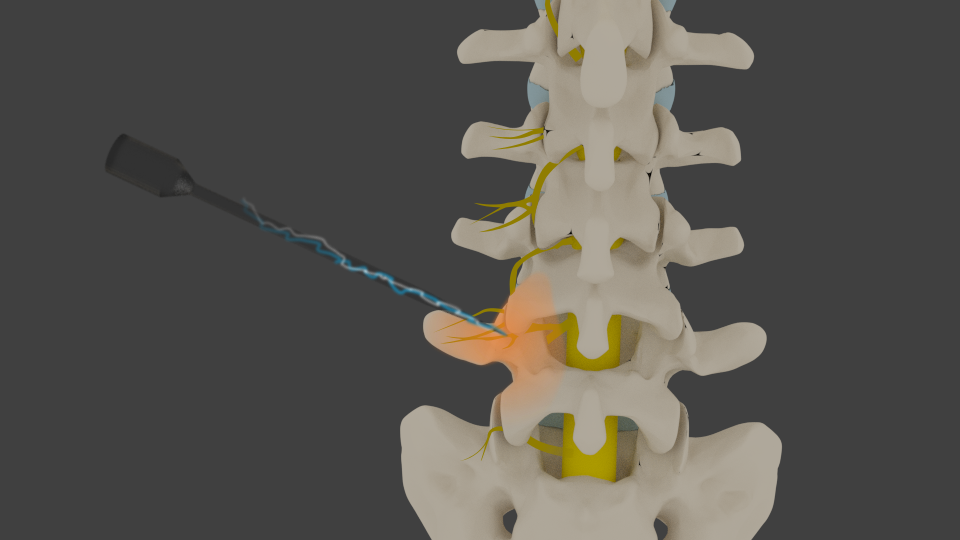Radiofrequency ablation is a term used when radio waves are used to produce heat to destroy tissue. It is a non-surgical option to treat your spine pain.
Spine pain is the second most frequent pain complaint. It occurs in 65 to 80 percent of the population at one time or another, and can be disabling and frightening. Its costs to society are great.
In the case of spinal pain, radiofrequency waves are transmitted through a needle placed into the facet joint under x-ray guidance. This procedure is also known as rhizotomy.
What do surgeons hope to achieve with this procedure?
There are several structures in the spine that can be a source of pain. One of the most common sources is the facet joint. The joints can develop arthritis and cause acute and chronic pain. The pain may come and go depending on activity.
Facet joint pain as the cause of back pain can be determined by a facet joint injection. This is called a diagnostic injection, meaning the doctor uses it to help make a diagnosis. The physician using x-ray guidance will inject the facet joint(s) in question with a small amount of a combination of local anesthetic and cortisone. Relief of the acute or chronic problem while the joint is numb indicates that you will likely have a good response to radiofrequency ablation.
Radiofrequency ablation uses radio waves to produce heat to destroy the nerve(s) carrying the pain signals from the facet joint. Once the nerves carrying pain sensation from the joints are destroyed, your pain should be reduced. This should allow you to do more activity, and decrease your pain medications.
Preparation How should I prepare for the surgery?
Your surgeon will discuss the preoperative guidelines. Follow your surgeon’s instructions. These instructions may include:
- Do not eat or drink for at least six hours before the procedure. You will be able to take your usual medication with a small amount of water. If you have diabetes, do not take your insulin or diabetic pills until after the procedure.
- You will need a driver to return home.
- Do not take any aspirin or aspirin-containing medication at least eleven days before the procedure. They may prolong bleeding.
- Wear loose fitting clothing that is easy to take off and put on.
- Take a shower the morning of the procedure, using a bactericidal soap to reduce chances of infection.
- Do not wear jewelry.
Procedure What happens during the procedure?
When the procedure is to begin, an IV will be started. This will allow the use of medications to help sedate you and make the procedure more comfortable. It is also important to have IV access for medications if you should have an allergic reaction during the procedure. You should be awake for the procedure to help the doctor with correct placement of the electrode used for radiofrequency ablation. You will not be given a general anesthetic. The area to be treated will be cleaned and then numbed with a local anesthetic.
Using x-ray guidance, the doctor will place the needle in the proper facet joint. A microelectrode is then placed inside the needle. A small radiofrequency current is then sent to the medial branch nerve of the joint capsule for approximately 60 to 90 seconds. The procedure is done with sterile technique to minimize the risk of infection.After the procedure, you will be taken to a recovery area. The nurses will monitor you and be sure you do not have an allergic reaction. You will be allowed to leave once you are stable.
After Care What should I expect after surgery?
Immediately following the procedure, you may have some relief of pain from the numbing medication used during the procedure. You will not be able to drive or do any physical activity for 24 hours. You may experience an increase in pain for the first several days following the procedure. Additional pain medications may be necessary to make you comfortable. If these include narcotics, you will need to watch for constipation. Drink lots of fluids and eat foods with plenty of fiber. If constipation should occur you will need to use a laxative, available over-the-counter. You may also note some swelling and bruising where the needle was inserted. Using a cold pack may ease the discomfort. Occasionally infection or bleeding can occur at the site of the procedure.
If you have a fever of 101 degrees or greater, chills, or redness or drainage at the treatment site, call your doctor. The degree of pain relief varies from person to person. The maximum decrease in pain may take up to three or more weeks to occur. You can eventually expect 50 percent or greater pain relief. Pain relief can last from six to12 months or even longer. The nerves do repair themselves and your pain may return. The procedure may be done again.
Your doctor will arrange a follow-up appointment, or phone consult within three to four weeks after the procedure to see how you are doing.
Rehabilitation What should I expect during my rehabilitation?
It is important that you start a program of conditioning, strengthening, and range of motion exercises after radiofrequency ablation. Ideally, increased muscle strength around the arthritic joints will make them less painful for several months after radiofrequency ablation. When the nerves do regenerate, you will not experience the same amount of pain as before the procedure. You may be asked to participate in a formal physical therapy program.




